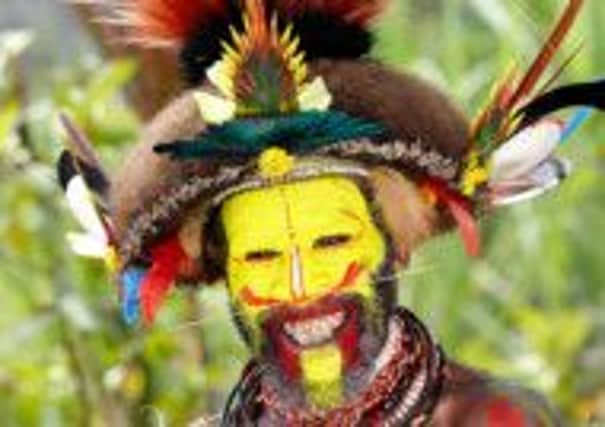Taste of bounty country


‘Never spend more than 24 hours with a woman,” the village “bigman” huskily intones, pausing to scratch his nose with the sharpened tip of an arrow. “It will make a man lose his magic and his powers will be weakened.”
Advice from a Huli tribesman in the Papua New Guinea Highlands is generally heeded, especially if given by a man whose facial expression is masked under red and yellow war paint, whose nose is pierced by the long quill of a cassowary, and who is naked apart from a pig-tail belt. Seated around an open fire in the gloom of a smoke-stained hut, my interpreter explains that to preserve his “powers” the chief lives separately from his three wives.
Advertisement
Hide AdAdvertisement
Hide AdWife number one lives next door in a similar lean-to, sharing space with the pigs and children. Other wives and relatives are housed around the settlement, guarded on all sides by steep mud walls designed to deter attacks from marauding neighbours.
While the women tend to the cooking, children and pigs, the chief devotes his thoughts to the two great concerns of the Huli male – war and gardening.
Papua New Guinea is a place you don’t forget in a hurry. Sandwiched between Northern Australia’s Cape York Peninsula and the sultry haze of the Equator, New Guinea is the world’s second largest island. While Papua New Guinea occupies the eastern part of the island, Papua and West Papua in the west belong to Indonesia.
The island is the most culturally diverse place on earth with more than 800 languages spoken by its seemingly limitless ethnic groups and tribes. This variety is matched by New Guinea’s wildlife where kangaroos live in trees and birds appear to strut about in fancy dress. This startling diversity is best expressed in the Highlands – a vast, previously impenetrable region sheltering fertile valleys where the majority of Papuans live.
Advertisement
Hide AdAdvertisement
Hide AdTari is Huli territory. Traditional culture thrives here. The unsealed Highlands Highway is the only road, where Huli saunter barefoot, casually swinging machetes, their heads crowned with bamboo creepers – a Huli mark of respect to the jungle.
Children pause from pig-walking duties to wave as our van travels ever higher to Ambua Lodge, situated at 7,000ft in the Tari Gap, a famous bird-watching area.
When I visited, the village was preparing for a festival. Gardening is temporarily forgotten, head-dresses are dusted off, cassowary quills straightened through septums and face-paint applied via plastic hand-held mirrors. Carved pig ribs, giant hornbill beaks and blue beads adorn necks.
A forest clearing reveals men delicately tending to oversized wigs. Huli wigmen are famous across PNG. They attend wig schools where they’re taught incantations to encourage hair growth. The hair is then harvested and used for ceremonial wigs. Selling these helps the young men save for the all-important “bride price”.
Advertisement
Hide AdAdvertisement
Hide AdPNG is also one of the world’s best birding locations. A lack of predators and glut of food has encouraged extravagant diversity, epitomised by the birds-of- paradise.
A 5am start reveals the silhouette of a tennis ball attached to a metre-long black streamer bouncing through the dawn gloom. “Stephanie’s Astrapia,” Peter mouths – my first ever bird-of-paradise.
This is bettered by the appearance of a thrush-sized bird with TV antennae protruding from its forehead. Binoculars reveal the antennae to be checked blue and black – King of Saxony bird-of-paradise is added to my list.
Madang, on PNG’s north coast, provides welcome respite after the nervous excitement of the Highlands. More developed than the Highlands, Madang’s stifling tropical heat lends the region a laid-back feel. It’s also one of PNG’s diving jewels, boasting gin-clear water, extravagant wildlife and carcasses of warships holed during WW2.
Advertisement
Hide AdAdvertisement
Hide AdBeing a coward I opt for snorkelling. A hollowed-out canoe deposits me on a coral cay seemingly lifted from a Bounty advert. Psychedelic fish dance like underwater butterflies before my face-mask – zebra stripes, vermilion, sulphur with a blue trim – every feasible pattern is represented.
I recall the “bigman’s” warning. I’d spent much longer than 24 hours with Papua New Guinea. Rather than stealing my powers, her magic had soaked me to the core.
Getting there
Liam Creedon flew courtesy of Singapore Airlines (www.singaporeair.com) and Air Niugini (www.airniugini.co.uk), with Trans Nuigini Tours (www.pngtours.com). Trips from £4,775 per person based on two people travelling, including international and domestic flights, transfers, accommodation, most meals and all excursions.
For further information about PNG visit www.papuanewguinea.travel and www.wildlifeworldwide.com